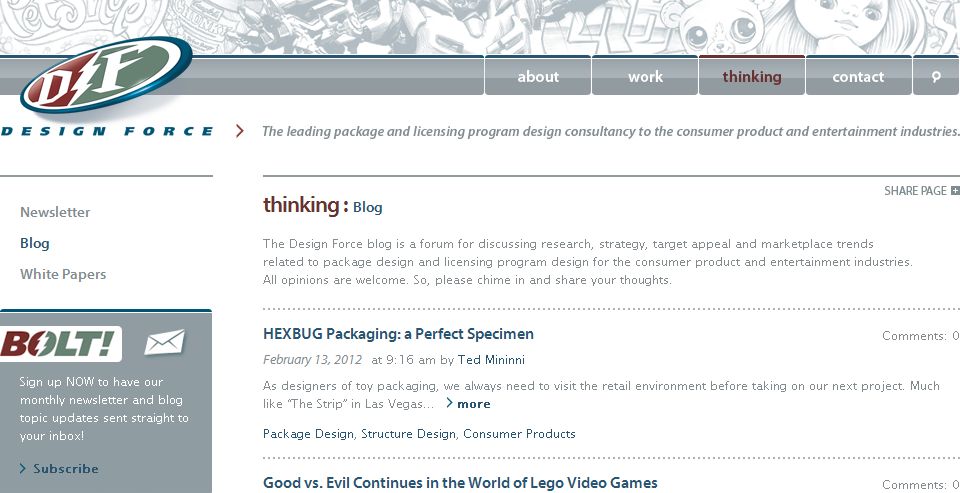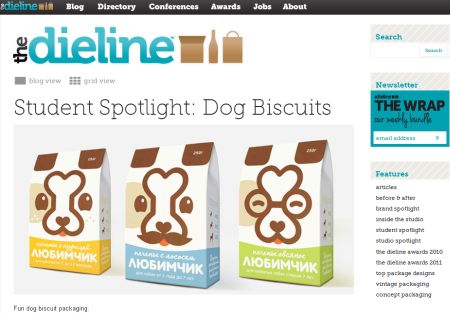American packaging design industry veteran, Ted Mininni of Design Force, considers how the design providers became more ‘left-brained’ and analytical over years, shares the firm’s ‘survival strategy’ for the recessionary times and recommends some good and inspiring read for the U.S. peers.
 Popsop: Ted, you’ve got such a not American last name — Mininni. Do you have an Italian background?
Popsop: Ted, you’ve got such a not American last name — Mininni. Do you have an Italian background?
T.M.: Yes, my family is Italian American. My grandfather came to the United States from Italy during the early part of the 20th Century and settled in Philadelphia, like many other Italian immigrants did. I’m very proud of my heritage.
Popsop: You’ve been working in the design industry in the US for more that 2 decades. How has the industry itself changed? How has your business, Design Force, Inc., evolved over years? What is your firm now?
T.M.: The design industry has evolved as the industry sectors we service have. As a design resource, we’ve had to become more left-brained and analytical to work with our clients as their needs evolved. For Design Force, I’d say our primary focus has always been on developing package design for what we refer to as “Enjoyment Brands”. However, due to the fact that many of our clients were in the toy and entertainment industry, we began developing licensing program style guides for their consumer product and entertainment brands with the approach of the new Millennium.
Currently, we focus on package design and licensing program design for the consumer product and entertainment industries.
Popsop: We are asking this question every interviewee, and would appreciate to hear your story. How did you overcome the recession, what was your ‘survival’ strategy?
T.M.: Simply put: we focus on building strong relationships with our clients. We work hard to understand their brands and their marketing challenges so that we can provide great design solutions. When we consistently deliver outstanding design, it impresses our clients and helps us to build and maintain long-term business partnerships. That’s the best antidote to recessionary times.
Popsop: I’m sure you are familiar with various packaging design pieces from all over the world. What’s, to your mind, a modern American package design? How does it differ from what we see in the UK, for example? In both branded and private label sectors.
T.M.: There is great package design work being executed in the U.S. and all over the globe. The primary difference is cultural context. Package structure, graphics, use of color and cultural cues that have meaning in the U.S. don’t necessarily in the U.K or elsewhere. Yet in both branded and private label packaging that is successful anywhere in the world, there is one common trait. Great design work leverages the brand and its key assets and consistently delivers to build trust. It just has to be culturally relevant and continue to contemporize the brand for relevance without discarding its most important heritage cues.
Popsop: What are your thoughts on advertising vs package design? In one of your articles published back in 2008, you argued on the fact that the ‘advertising was dead’. Do you still think so now, when the recession seems to be over?
T.M.: Quite frankly, that article was written to grab the reader’s attention; and it was deliberately over-stated. Advertising has an important role in marketing. It isn’t “dead”, but it does have to be rethought. The marketplace is too fragmented now and target audiences are increasingly online so that fewer people are being reached by conventional advertising. My point in the article is that some of the resources once allocated to general advertising might be better spent on packaging. Why? Because it makes the brand and its products tangible and consumers interact with it directly. So why shouldn’t packaging get a higher allocation of marketing dollars? Remember that advertising brings consumers into stores but packaging either sells the product or fails to sell it at the shelf.
Popsop:Your firm provides a bunch of special services called ‘licensing program design’? What are they?

Pic. Design Force Blog, screen printout
T.M.: Design Force works with licensors of high profile intellectual properties in the consumer product and entertainment industries to develop the design assets as well as the guidelines for their standardization for licensees to use as they develop their licensed consumer products. This is typically delivered in the form of a printed or digital “style guide”. These services include, pre-design market and trend research, creative strategy development, design assets development, product concept development and style guide design. We’re often engaged to develop the packaging program and its standardization for these properties as well.
Popsop: It seems that you love writing as much as the design. You’ve been and still are a regular contributor to some major US branding, design and marketing publications such as Brand Packaging Magazine, Package Design Magazine, Brandchannel.com, Shelf Impact! Moreover, I see that your blog on the Design Force website is being updated weekly. How do you find time, and, what’s more surprising, inspiration to write that frequently? What is writing for you: mostly, a way to promote your business or a necessity to share your knowledge with others?
T.M.: What you’re seeing in my writing is my passion for all things having to do with our core competencies. And the output you refer to has been produced over the past few years. I’ve approached writing in a consistent manner. The design community benefits from sharing ideas and thought processes. I love reading insights from other experts and sharing my own. After all, design is a collaborative art and science. We collaborate with our clients and we share with students and professionals in various design disciplines so that we all learn and evolve. We’re all striving for excellence.
The Design Force blog began in June of 2011 when we re-launched our current web site. We decided to add the blog to our site so that we could share our thoughts about current topics in a consistent, ongoing manner. It’s a forum for discussing research, strategy, target appeal and marketplace trends related to the disciplines of package design and licensing program design as well as the consumer product and entertainment industries. I invite your readers to visit our blog and share their thoughts. Everyone’s point of view is welcome: Design Force Blog.
I carve out the time to put my thoughts in writing, which means that I may often put in some long days at the office. But writing helps to clarify ideas and processes that actually assist us in evolving and improving our design approach, and the high quality results that it produces. That clearly has great value.
Popsop:What’s your favourite professional magazine or website that you regularly follow and get inspiration for your work? Why?
T.M.: Our entire design team enjoys reading TheDieline.com as well as a variety of print and online versions of packaging trade publications in the U.S. that offer quality articles: Packaging World, Package Design Magazine, Brand Packaging and Packaging Digest are all excellent publications. On the licensing side, we read Li©ence Magazine and subscribe to various newsletters such as the LIMA Smartbrief, so we can keep our fingers on the pulse of that industry as well. We also read the leading design publications, such as Print Magazine and Communication Arts, so that we’re not only influenced by what’s going on in the industries we service.
Pic. TheDieline.com, screen printout
Popsop: I’ve noticed that you were among the first and loyal contributors to The Dieline Opinion Series. What’s your relationship with this website and why do you think it’s become so successful and commercially diversified over a short period of time?
T.M.: I remember being impressed by TheDieline.com and submitted an article to them for consideration when the publication was still in its infancy. Andrew Gibbs, the founder, published it and then invited me to submit articles with frequency to support the site. I was delighted to do so. Andrew has vision. He’s added a package design conference and The Dieline Awards which enable design experts to judge package design entries from around the globe. There’s a weekly newsletter now and Andrew continues to push all things packaging using all of these platforms.
Popsop: I know that the USA is among those countries which take sustainability issues very seriously. What does the word ‘sustainability’ mean to you personally? How do you apply its principles (if you do) to your business?
T.M.: Sustainability has taken root in the U.S. and around the globe for a number of reasons. It comes down to this for me: we have finite natural resources and must use them wisely. Reducing, recycling and repurposing makes sense, including packaging. As our clients, manufacturers of consumer products, make inroads in these areas, we have to collaborate with them to deliver optimal design solutions and do it in a responsible manner. Understanding our clients’ sustainability initiatives helps us to work more closely with them.
Popsop: What is the greatest thing you’ve ever done in your life and will always be proud of?
T.M.: I’ve been fortunate to have many successes in my life, both personally and professionally. Having had the opportunity to establish the visual course for many of the world’s most high profile consumer product and entertainment brands is truly something to be proud of. But, I’d have to say that being a parent rates at the top of the list.
